Related Research Articles

Louis Laurent Marie Clerc was a French teacher called "The Apostle of the Deaf in America" and was regarded as the most renowned deaf person in American Deaf History. He was taught by Abbé Sicard and deaf educator Jean Massieu, at the Institution Nationale des Sourds-Muets in Paris. With Thomas Hopkins Gallaudet, he co-founded the first school for the deaf in North America, the Asylum for the Education and Instruction of the Deaf and Dumb, on April 15, 1817, in the old Bennet's City Hotel, Hartford, Connecticut. The school was subsequently renamed the American School for the Deaf and in 1821 moved to 139 Main Street, West Hartford. The school remains the oldest existing school for the deaf in North America.

Van Asch Deaf Education Centre was located in Truro Street, Sumner, Christchurch, New Zealand. It was a special school for deaf children, accepting both day and residential pupils, as well being as a resource centre providing services and support for parents, mainstream students and their teachers in the South Island and the Lower North Island.
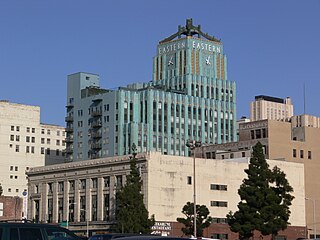
The Historic Core is a district within Downtown Los Angeles that includes the world's largest concentration of movie palaces, former large department stores, and office towers, all built chiefly between 1907 and 1931. Within it lie the Broadway Theater District and the Spring Street historic financial district, and in its west it overlaps with the Jewelry District and in its east with Skid Row.

Broadway, until 1890 Fort Street, is a major thoroughfare in Los Angeles County, California, United States. The portion of Broadway from 3rd to 9th streets, in the Historic Core of Downtown Los Angeles, was the city's main commercial street from the 1910s until World War II, and is the location of the Broadway Theater and Commercial District, the first and largest historic theater district listed on the National Register of Historic Places (NRHP). With twelve movie palaces located along a six-block stretch, it is the only large concentration of movie palaces left in the United States.
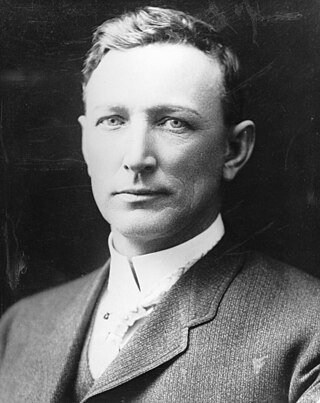
Owen McAleer was a Los Angeles, California, businessman who was mayor of the city between 1904 and 1906. His brother Jimmy McAleer played in Major League Baseball.

The American School for the Deaf (ASD), originally The American Asylum, At Hartford, For The Education And Instruction Of The Deaf, is the oldest permanent school for the deaf in the United States, and the first school for deaf children anywhere in the western hemisphere. It was founded April 15, 1817, in Hartford, Connecticut, by Thomas Hopkins Gallaudet, Mason Cogswell, and Laurent Clerc and became a state-supported school later that year.

May Company California was an American chain of department stores operating in Southern California and Nevada, with headquarters at its flagship Downtown Los Angeles store until 1983 when it moved them to North Hollywood. It was a subsidiary of May Department Stores and merged with May's other Southern California subsidiary, J. W. Robinson's, in 1993 to form Robinsons-May.
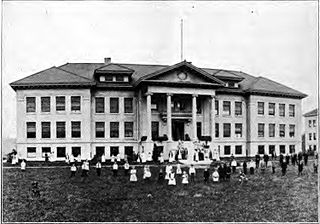
Oregon School for the Deaf (OSD) is a state-funded school in Salem, Oregon, United States. It serves deaf and hard of hearing students from kindergarten through high school, and up to 18 years of age.
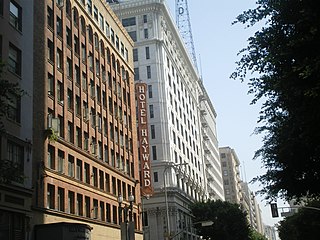
Spring Street in Los Angeles is one of the oldest streets in the city. Along Spring Street in Downtown Los Angeles, from just north of Fourth Street to just south of Seventh Street is the NRHP-listed Spring Street Financial District, nicknamed Wall Street of the West, lined with Beaux Arts buildings and currently experiencing gentrification. This section forms part of the Historic Core district of Downtown, together with portions of Hill, Broadway, Main and Los Angeles streets.

The Sir James Whitney School for the Deaf is a provincial school in Belleville, Ontario with residential and day programs serving elementary and secondary deaf and hard-of-hearing students.

Broadway-Spring Arcade, also known as Broadway Arcade, Spring Arcade, Arcade Building, and Mercantile Arcade Building, refers to three adjoining buildings located at 540 S. Broadway / 541 S. Spring Street. The buildings face both Broadway and Spring Street, connecting the Broadway Theater and Spring Street Financial districts midway between Fifth and Sixth streets in the historic core of downtown Los Angeles.
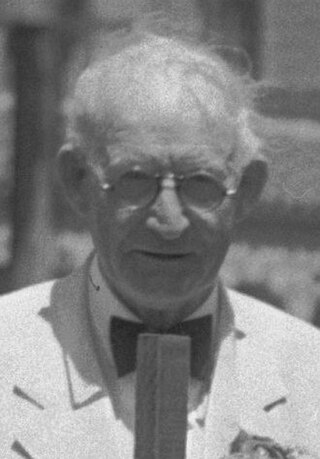
William Miller Bowen was an American lawyer and civic leader in Los Angeles. He was a member of the Los Angeles City Council is known as the "Father of Exposition Park."

The Halifax School for the Deaf was an institution in Halifax, Nova Scotia, Canada, which opened on 4 August 1856. It was the first school of the deaf in Atlantic Canada. There was later a dispute over who the true founder was, William Gray (1806-1881), a deaf Scottish immigrant who was the first teacher in the back room of a house in Argyle Street, or George Tait (1828-1904), another deaf Scot, who claimed to have been the driving force behind the establishment of the school. Gray was sacked in 1870 for being intoxicated and for threatening pupils with violence.

The Bumiller Building is a residential building in the Los Angeles Historic Broadway Theater District. Built in 1906 and designed by the architects Morgan & Walls, the Bumiller Building was constructed of reinforced concrete in Renaissance Revival style. Historically the building has been a department store and a theater.
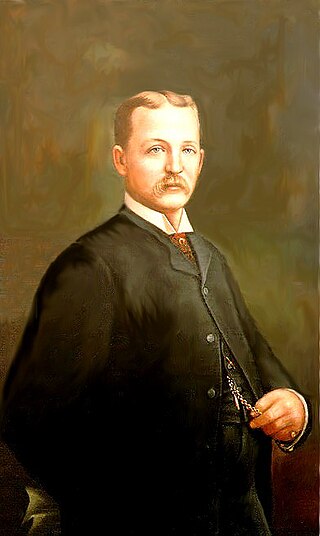
Samuel Thomas Greene was a Deaf American educator and Ontario's first Deaf teacher in 1870 at the Ontario Institution for the Education of the Deaf and Dumb, which later changed to Sir James Whitney School of the Deaf in Belleville, Ontario, Canada. He was born in 1843 in Portland, Maine and attended America's first Deaf school in Hartford, Connecticut.

Joseph Watson was an English teacher of deaf children, and writer on teaching the deaf.
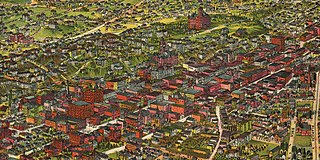
The late-Victorian-era Downtown of Los Angeles in 1880 was centered at the southern end of the Los Angeles Plaza area, and over the next two decades, it extended south and west along Main Street, Spring Street, and Broadway towards Third Street. Most of the 19th-century buildings no longer exist, surviving only in the Plaza area or south of Second Street. The rest were demolished to make way for the Civic Center district with City Hall, numerous courthouses, and other municipal, county, state and federal buildings, and Times Mirror Square. This article covers that area, between the Plaza, 3rd St., Los Angeles St., and Broadway, during the period 1880 through the period of demolition (1920s–1950s).

7th Street is a street in Los Angeles, California running from S. Norton Ave in Mid-Wilshire through Downtown Los Angeles. It goes all the way to the eastern city limits at Indiana Ave., and the border between Boyle Heights, Los Angeles and East Los Angeles.

Retail in Southern California dates back to its first dry goods store that Jonathan Temple opened in 1827 on Calle Principal, when Los Angeles was still a Mexican village. After the American conquest, as the pueblo grew into a small town surpassing 4,000 population in 1860, dry goods stores continued to open, including the forerunners of what would be local chains. Larger retailers moved progressively further south to the 1880s-1890s Central Business District, which was later razed to become the Civic Center. Starting in the mid-1890s, major stores moved ever southward, first onto Broadway around 3rd, then starting in 1905 to Broadway between 4th and 9th, then starting in 1915 westward onto West Seventh Street up to Figueroa. For half a century Broadway and Seventh streets together formed one of America's largest and busiest downtown shopping districts.
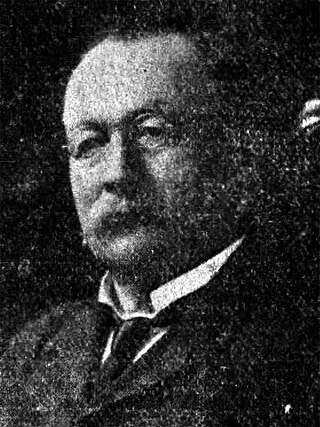
Jacob Frankenfield was an American businessman and politician who served in the Minnesota Senate from 1874 to 1875 and Los Angeles City Council from 1885 to 1890. He was the President of the Los Angeles City Council for a year, and during his tenure helped with the building of the Los Angeles City Hall and helped change the name of Fort Street to Broadway.
References
Access to the Los Angeles Times links may require the use of a library card.
- ↑ Doug Smith, "Old School: Garvanza Elementary Is Celebrating 100 Years as a Los Angeles Campus," Los Angeles Times. September 22, 1999
- ↑ G.L.N. (letter), "The Proposed Trade," Los Angeles Herald, October 14, 1873, page 3
- ↑ "Local Brevities," Los Angeles Herald, December 19, 1875, page 3, column 3
- ↑ "The Board of Education," Los Angeles Herald, January 5, 1876, page 3
- ↑ "Local Brevities," Los Angeles Herald, October 9, 1875, page 3
- 1 2 3 "Jail-Like Schoolhouse," Los Angeles Herald, June 2, 1881, page 1
- 1 2 "Record Realty Deal Is Made," Los Angeles Times, November 7, 1922, page II-1
- ↑ Bensel Smythe, "When Broadway Was a Cow-Path," Los Angeles Times, December 17, 1933, page H-10
- ↑ Location as shown on Mapping L.A.
- 1 2 "The Teachers: Second Day of the Annual County Institute," Los Angeles Times, April 20, 1887, page 3
- ↑ "Final Instructions: Conference of Principals Regarding the Close of School," Los Angeles Times, June 18, 1896, page 8
- ↑ "Women's Clubs: Annual Conference,"Los Angeles Times, March 20, 1904, page 9
- ↑ "The Deaf and Dumb: They Will Be Taught in the Spring-Street School," Los Angeles Times, September 13, 1898, page 8
- ↑ "School Flag Raising," Los Angeles Times, January 15, 1903, page 7
- ↑ "School Exhibit: Extensive Display at the Spring-Street School,' Los Angeles Times, July 9, 1899, page C-1
- ↑ "Spring-Street School to Go," Los Angeles Times, April 26, 1904, page A-8
- ↑ "Unique New Arcade in Heart of City," Los Angeles Times, May 27, 1904, page A-1
- ↑ "Wants Greater Leasing Power," Los Angeles Times, January 17, 1913, page II-2
- ↑ "Leases Mercantile Place," Los Angeles Times, February 14, 1914
- ↑ "Weary Voters Dodge Polls," Los Angeles Times, March 27, 1914, page II-1